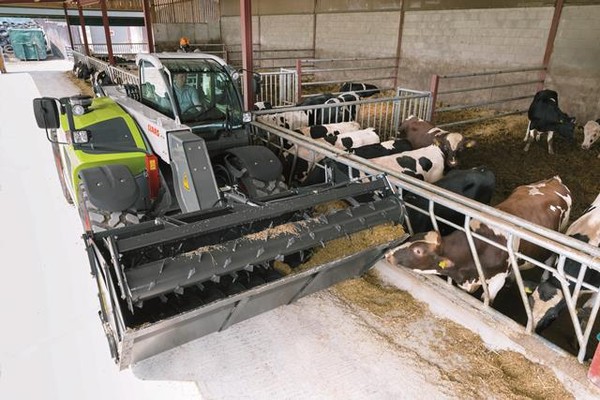
Performance and maneuverability for the new Scorpion range by Claas
The restyled line of telescopic handlers by the German manufacturer now brings together three compacts and three high performance models. Debuting across the entire Scorpion range are a redesigned heavy-duty chassis, a protection system which checks overloading and new low emissions engines
In the increasingly competitive sector of agriculture where telescopic handlers have become indispensible machines for farming and big livestock raising operations as well as contractors and biogas producers, market demand has polarized around two distinct categories of handlers. These are the top-of-the-range high performance machines with lift capacities of more than five tons and mid-range models featuring compact design and great maneuverability. In response to the trend in this sector Claas has redesigned their Scorpion line to bring out three high performance head-of-the-class models, the 9055, 7055 and 7044, with a turning radius of 3,755 mm, lifting capacity of 5.5 t and lifting heights of 7 m for the 7055 and 8.8 m for the 9055. The three compact models are the 7035, 7030 and 6030 with a turning radius of 3,750 mm.
Low center of gravity and new loading system
All the telescopic handlers in the Scorpion range mount the new generation heavy-duty chassis designed to handle the heaviest loads thanks to the torsion-resistant frame with a low center of gravity and a low boom pivot point. This means that during transport, the boom remains inside the frame to ensure excellent visibility to right and left for the operator. New design and new geometry by Claas also extends to the loading system with very high breakaway power of 72 kN and a residual load capacity of 2 t and lift, tilt and reach cylinders which now have end-of-travel damping to prevent impacts in the loading system. To accompany restyling of the loading system the manufacturer also redesigned the controls with new ergonomics for the instrument panel and joystick for selecting three steering modes. These drive ranges – 0–7 km/h, 0–15 km/h and 0–30/40 km/h – can be conveniently selected on the joystick and with the limitation of maximum speed, the system increases engine rpm to deploy maximum hydraulic power available.
Safety and productivity with Smart Handling
Available across the entire Scorpion range is Smart Handling, a system which protects against overloading. In each of the three operating modes, shoveling, stacking, vertical lift and manual mode, lowering speed is adjusted to the load on the loading system and angle of the boom. If the telescopic arm is fully retracted, the overload protection is deactivated to allow for the filling of the bucket or fork shunting operations to be performed with full power.
Great torque and limited emissions with new Deutz engines
All the redesigned Claas telescopic handlers are equipped with new generation Deitz engines which are in conformity with the Stage IIIB (Tier 4i) emission control norm. At the top of the range, the Scorpion 9055 and 7055 mount 4-cylinder power plants with displacement of 4.1 liters rated at 156 HP and the 7044, the 7035, 7030 and 6030 are powered by the Deutz 3.6 liter engines at 122 HP. For complying with the emission standard for the 4.1 liter engines, Claas deployed a combination of auto-cleaning DPF, and the fully maintenance-free DOC. For the 3.6-liter engine, exhaust gas aftertreatment consists of a maintenance-free DOC system only.
Also up for mention is the Claas introduction of a decidedly innovative air ducting concept for use under all conditions. The cooling air required is drawn in at the front into the upper part of the engine hood to then flow through the radiator, is channeled past the engine block and exits the engine compartment at the top rear section of the engine hood along with the exhaust gas. This air ducting effectively prevents dust and dirt being stirred up and sucked in. Clean air, on the other hand, is drawn in by the fan located between the battery, the radiator and engine. In the case of operations in dusty conditions, the fan rotation can be reversed to clear the dust from intake panels and the radiator.
Yet another strong point of the redesigned Scorpions is the hydrostatic Varipower transmission which automatically coordinates speed and thrust to enable the telescopic handler to progressively reach a top speed of 40 km/h.








